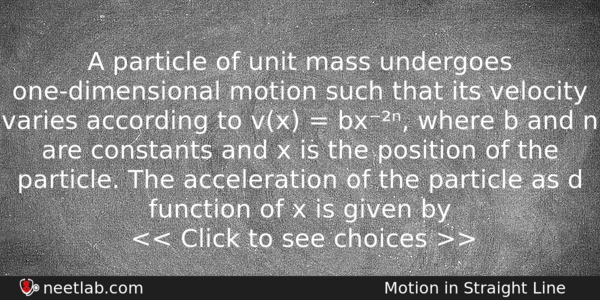| ⇦ | 
| ⇨ |
A particle of unit mass undergoes one-dimensional motion such that its velocity varies according to v(x) = bx⁻²ⁿ, where b and n are constants and x is the position of the particle. The acceleration of the particle as d function of x is given by
Options
(a) -2nb²x⁻⁴ⁿ⁻¹
(b) -2nb²x⁻²ⁿ⁺¹
(c) -2nb²e⁻⁴ⁿ⁺¹
(d) -2nb²x⁻²ⁿ⁻¹
Correct Answer:
-2nb²x⁻⁴ⁿ⁻¹
Explanation:
No explanation available. Be the first to write the explanation for this question by commenting below.
Related Questions: - If light emitted from sodium bulb is passed through sodium vapour,
- Which of the following statement about scalar quantity is true?
- The coefficient of mutual inductance of two coils is 6 mH. If the current flowing
- The workdone in turning a magnet of magnetic moment M by an angle of 90⁰ from the magnetic
- A transformer having efficiency of 90% is working on 200 V and 3kW power supply
Topics: Motion in Straight Line
(93)
Subject: Physics
(2479)
Important MCQs Based on Medical Entrance Examinations To Improve Your NEET Score
- If light emitted from sodium bulb is passed through sodium vapour,
- Which of the following statement about scalar quantity is true?
- The coefficient of mutual inductance of two coils is 6 mH. If the current flowing
- The workdone in turning a magnet of magnetic moment M by an angle of 90⁰ from the magnetic
- A transformer having efficiency of 90% is working on 200 V and 3kW power supply
Topics: Motion in Straight Line (93)
Subject: Physics (2479)
Important MCQs Based on Medical Entrance Examinations To Improve Your NEET Score
18000+ students are using NEETLab to improve their score. What about you?
Solve Previous Year MCQs, Mock Tests, Topicwise Practice Tests, Identify Weak Topics, Formula Flash cards and much more is available in NEETLab Android App to improve your NEET score.
Share this page with your friends

Leave a Reply